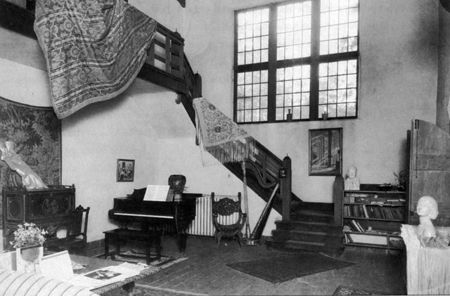Georges & Eleanor Bridges residence
The Georges Bridges residence is a pink-colored stucco house located at the center of a 2-acre lot at the corner of Edgewood Boulevard and Roseland Drive in Homewood's Edgewood community. It was constructed in 1921 for sculptor Georges Bridges and his wife, the former Eleanor Massey. The couple designed the house themselves and Georges built the carved wooden entrance doors.
The main room of the house features a vaulted ceiling reaching 28 feet above the floor, with a balcony running across one side. Outside the main house a stable sheltered horses, which the couple used to traverse the largely undeveloped area, then still known as a valley of dairy farms.
The house is surrounded by elaborate gardens, screened behind thick walls of wisteria-draped evergreens. During the Great Depression Eleanor had bunk rooms built to house children abandoned at mining camps in the Birmingham District. She housed and fed them, and led them in school lessons with a heavy dose of arts and crafts. When truant officers formally objected to the arrangement, she packed the children up and moved her school to Taxco, Mexico. After the children were either reunited with their families or placed with foster parents, the Bridgeses opened the bunkrooms up to patients of a local doctor who treated alcoholism. Both Eleanor and Georges continued to teach, volunteering at Edgewood Elementary School and at Birmingham's Parker High School.
Over the years the Bridges residence and its gardens hosted innumerable gatherings of the area's cultural elite, often at weekly "Salons" structured around a particular theme. Both the Little Theater and the Valley Civic Theatre trace their beginnings to entertainments at those gatherings, as does the Birmingham Theosophical Society. Among the notables entertained there were F. Scott and Zelda Fitzgerald, Ernest Hemingway, and Grand Duchess Marie Pavlovna of Russia. The Bridges raised their daughter, Mary Eleanor "London" Bridges in the house.
Eleanor Bridges was named "Birmingham Woman of the Year" in 1953 and led countless fundraisers and civic projects. She was forced to hand over the reigns of her "100-year plan to make Birmingham the cultural center of the South" when Georges fell ill in 1975. After Eleanor died in 1987 the house was sold to Eric and Diana Hanson. The gardens inspired their t-shirt and art print business that grew into the White Flowers retail shop. They sold the house to developer Pat O'Sullivan in 2004 to raise funds for medical bills, but continued to lease and maintain the 1.4-acre property until January 2019. O'Sullivan filed a 6-parcel subdivision plan shortly after purchasing the parcel. He plans to resubdivide into 5-lots, demolish the 1921 residence and outbuildings, and construct five new homes.
The Homewood Historical Preservation Society was formed in 2018, partly in order to try to lobby for the house's preservation.
References
- Rittenhouse, Berdine L. (January 21, 1980) "A Memoir: Eleanor Massey Bridges, Feminist: Life in a Segregated Society" oral history interview. UAB.
- Summe, Sheryl Spradling. (2001). Homewood: The Life of a City. Homewood, AL: Friends of the Homewood Public Library.
- Snell, Mary Ellen (June 26, 2012) "White flowers and the secret garden." Homewood Star
- Singleton, William C. III (June 14, 2018) "Bringing Down the House: Historic Homewood Residence Likely to Be Torn Down." Over the Mountain Journal
- Edgemon, Erin (June 27, 2018) "Secret garden house to be razed as Homewood's popularity soars." The Birmingham News
